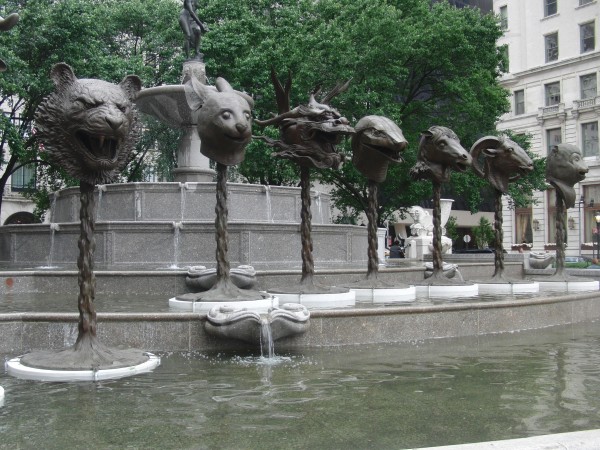
Ai Weiwei’s intricate “Zodiac Heads” are on view in the Pulitzer Fountain through July 15 (photo by twi-ny/mdr)
Pulitzer Fountain
Grand Army Plaza at Central Park
Fifth Ave. at West 58th St.
Through July 15, free
www.zodiacheads.com
online slideshow
On April 3, artist Ai Weiwei was arrested by the Chinese government, with little information about his whereabouts. An international Free Ai Weiwei campaign began, and on June 22 he was finally released on bail, having been charged with tax evasion, but that is far from the end of the story. “Despite the relief that Ai Weiwei is back with his family,” German foreign minister Guido Westerwelle said, “it remains a fact that his freedom is subject to oppressive restrictions.” As German politicians meet with Chinese officials to discuss human rights concerns, Ai Weiwei will remain in Beijing, where he has been ordered to stay for a period of one year. You can honor the onetime New Yorker, who lived here from 1981 to 1993, by visiting his first public installation in a major U.S. city, “Circle of Animals / Zodiac Heads,” which is on view in the Pulitzer Fountain in front of the Plaza through July 15. Based on a dozen sculptures designed by Giuseppe Castiglione as part of a water-clock fountain for the Garden of Perfect Brightness (Yanming Yuan) for the Qing dynasty in the mid-eighteenth century — and was looted and burned by British and French troops at the conclusion of the Second Opium War in 1860 — the large-scale work features twelve bronze animal heads, each relating to a sign of the zodiac. The intricately detailed heads range from the rat, the ox, and the tiger to the rabbit, the snake, and the horse, from the ram, the rooster, and the monkey to the dog, the boar, and the most fanciful, the dragon.
Ai Weiwei is not seeking to make any grand statements with the fun display, which incorporates history, war, memory, folklore, and astrology. “I think it’s something that everyone can have some understanding of, including children and people who are not in the art world. I think it’s important to show your work to the public. That’s what I really care about,” Ai Weiwei explains in the exhibition catalog, which includes a photo of each head and a description of that zodiac sign, along with an essay by Susan Delson and excerpts of interviews with the artist about the project. “Anybody can make a set of zodiac figures,” he continues. “We never change the subject, we always change the interpretation. . . . I am always concerned with how we make judgments. And in questioning others’ judgment, and also questioning my judgment. And always saying art is not the end but the beginning. Art is not the end. The product is never the end but should be the beginning. Otherwise art has no life.” Thus, just as with Ai Weiwei’s personal freedom, “Circle of Animals / Zodiac Heads” should not be seen as the end of the story.